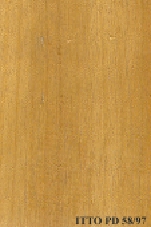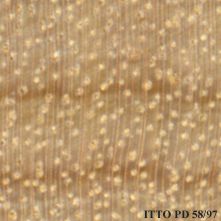
SAFUKALA (Dacryodes heterotricha)
Trade Name
Safukala
Scientific Name
Dacryodes heterotricha H.J.Lam
Family
BURSERACEAE
Common Names
Safucala (France); Safoukala (France); N'safu-nkala (Zaire); Mouganga (Gabon); Safucala (Congo); Safoukala (Angola); N`safu-nkala (Zaire); Safucala (Angola); Safoukala (Congo); Safukala
Scientific Name Synonyms
Pachylobus pubescens; Pachylobus heterotricha Pellegr.; Pachylobus ferrugineus A. Chev. & Pellegr.
Description Of The Tree
Botanical Description
The tree may reach up to 40 m. The bole is usually straight and cylindrical, often unbuttressed. The trunk diameter attains 70 up to 170 m.
Natural Habitat
Dacryodes heterotricha is prevalent in rain forests as a dominant or codominant species.
Natural Distribution
West Africa.
Wood Identification
Anatomic Description Of Wood
Wood diffuse porous. Occasionally vessels exclusively solitary (over 90%). Tangential diameter of vessel lumina 150 to 200 micras (medium). Tyloses thin walled. Non-vestured pits. Vessels per mm2 6 to 10 (medium). Simple perforation plates. Vessel-ray pits coars Paratracheal axial parenchyma scanty and/or vasicentric. 4 to 10 rays per mm (medium). Rays non-storied. Rays commonly 2 seriate. Silica bodies in the ray cells. Occasionally prismatic crystals in the ray cells. Body ray cells procumbent with one row of upright and/or square marginal cells (Kribs-III). Septate fibers present. Fibers with simple to minutely bordered pits.
-
 Wood Macro Photo Tangential Plane
Wood Macro Photo Tangential Plane
-
 Wood Micro Photo Of Transversal Section
Wood Micro Photo Of Transversal Section
Availability
Cites Status
Unrestricted
General Wood Description
Color
The sapwood is whitish. The heartwood is pinkish grey buff to pale brown, it is not clearly demarcated. The silver figure is fine.
COLOR INDEX (1=Black, 7=Light yellow,white)
5
Grain
Straight or slightly interlocked.
Texture
The wood is typically medium in texture.
Luster
This wood is commonly of low luster.
Natural Durability
Moderately durable to decay. Without preservative treatment, this species can be used only under risk of occasional re-humidification. It is not suited for uses with risks of permanent or long-lasting humidification. Resistant to termites attack. The hear
Natural durability index (1= Very high durability, 7=Vey low durability)
3
Internal Growth Stresses
No residual growth stresses are found.
Silica Content
Silica Content: Presence of silica is reported in timber of this species. Amounts over 0.05% may affect the wood processing. Silica Value: 0.6
Resistance To Impregnation
Difficult to treat with only a low penetration of the preservative products.
Wood Physical Properties
Basic Density or Specific Gravity (O.D. weight/vol. green) (g/cm³)
0.63
Air-dry Density (Weight and volume at 12%MC) (g/cm³)
0.69
Total shrinkage Tangential (Saturated to 0%MC) (%)
7.6
Total shrinkage Radial (Saturated to 0%MC) (%)
4.6
Drying Defects
Ease of Drying: Air drying is rated as good with little degrade.
Recommended Dry Kiln Schedule
FR-8
Dimensional stability ratio (Total Tangential Shrinkage %/Total Radial Shrinkage %)
1.6
Wood Chemical Properties
Wood Mechanical Properties
Bending Strength (MOR),12%MC (kgf/cm²)
1182
Stiffness (MOE) 12%MC (kgf/cm²)
168434
Compression parallel to fiber 12%MC (kgf/cm²)
656
Compression perpendicular to fiber 12%MC (kgf/cm²)
89
Shear strength radial 12%MC (kgf/cm²)
131
Janka hardness (side) 12%MC (kgf)
598
Janka hardness (end grain) 12%MC (kgf)
695
Workability
Sawing
It is easy to saw.
Rotary Veneer Cutting
Suitable for peeling if treated.
Sliced Veneer
Suitable for peeling if treated.
Blunting Effect
Moderate blunting effect; stellited blades for sawing and carbide tools for machining are advised.
Machining
Possible difficulties caused by interlocked grain are reported.
Planing
Moderately easy; tools must be cautiously sharpened.
Moulding
Moderately easy; tools must be cautiously sharpened.
Boring
Moderately easy; tools must be cautiously sharpened.
Mortising
Moderately easy; tools must be cautiously sharpened.
Nailing
Pre-boring is necessary.
Gluing
Glues well if basic gluing technical rules are followed.
Sanding
Easy to perform; it gives good results.
Polishing
Can be polished without surface preparation.
Response To Hand Tools
No particular problems.
REFERENCED USES
End Uses Summary
HOUSING GENERAL, beams, joists, boards, flooring, parquet, frames, steps, panelling, fittings, shutter boards, FURNITURE AND CABINETS, common furniture, PLYWOOD AND VENEER, faces, cores, PACKING, heavy packing, pallets, OTHER AND MUSICAL INSTRUMENTS, door core, coffin
General Housing
- 10 - Silica in Timbers
Beams
- 11 - Prospect: The wood database
Joists
- 12 - Tropical timbers of the world. Part I-Tropical American Species
Boards
- 13 - Dry kiln schedules for commercial woods. Temperate and tropical. Section III. Latin American (Mexico, Central, and South America) Woods–Conventional Temperatures
Flooring
- 14 - Handbook of Hardwoods
Parquet
- 15 - Empire Timbers
Frames
- 16 - Woods of the World
Steps
- 17 - Tree Conservation Database
Paneling
- 18 - W3TROPICOS Missouri Botanical Garden
Fittings
- 19 - Silica in Timbers
Shutter Boards
- 20 - Prospect: The wood database
Furniture Cabinets
- 21 - Tropical timbers of the world. Part III-Southeast Asian and Oceanian Species.
Furniture, Common
- 23 - Handbook of Hardwoods
Panels, Veneers
- 25 - Directory of Timber Trade Malaysia
Faces
- 26 - Annual Review and Assessment of the World Timber Situation 1998-ITTO
Cores
- 27 - Embassy of Brazil in Japan
Packing
- 45 - Recopilación y Análisis de Estudios Tecnológicos de Maderas Peruanas
Heavy Packing
- 47 - Arvores Brasileiras
Pallets
- 48 - The strength properties of timbers
Door Cores
- 76 - Descripción General y Anatómica de 105 Maderas del Grupo Andino.
Coffin
- 78 - Amazonian Timbers for the International Market
Please Provide Information To View Producer Information